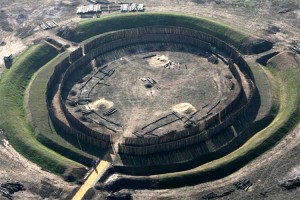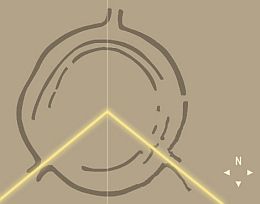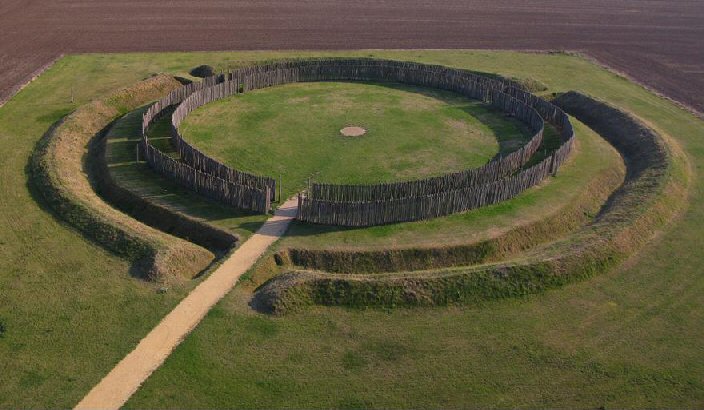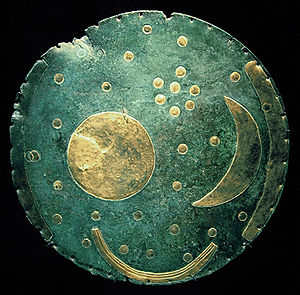|
Location:
Goseck, Saxony-Anhalt, Germany. |
Grid Reference:
51� 12′ 1″ N,
11� 51′ 51″ E. |

 Goseck Henge:
(The 'German Stonehenge').
Goseck Henge:
(The 'German Stonehenge').
The Goseck Henge is
an early Neolithic Henge-structure with entrances orientated to the
rising and setting winter solstice sun. At c. 5,000 BC, the Goseck 'Henge' is considered the earliest solar observatory
currently known in the world.
(2).
It lies on the same latitude as Stonehenge. (51� 10' 42" N, 1� 49.4'
W), at just over 1' minute of longitude further north (approx 1000m
). The Stonehenge 'Post-holes' are dated
at least a thousand years earlier than this monument, but the Henge
is considerably older than the one in England.
|
Goseck: Form and Function. |
When
archaeologists Peter Biehl and Francois Bertemes decided to
excavate a 7,000-year-old circular enclosure outside of Goseck,
Germany, in 2002, they didn't expect to make any major
discoveries, certainly nothing that might rewrite the history of
Neolithic Europe. "We had just started our archaeology program,
and we wanted a place near the university for our students to
practice," says Biehl, formerly a professor at
Halle-Wittenberg University and now at Cambridge. Combining
Global Positioning System data with archaeological evidence from
the site, they realised that the two southern gates of the Henge marked
the start of the summer and winter solstice, making the
enclosure possibly the world's oldest solar observatory. The
farmers of Neolithic Central Europe, who most scholars believed
were a generally unsophisticated group who tilled the land with
basic wooden tools, were actually measuring the heavens far
earlier than anyone had ever believed.
(1)
The Goseck
enclosure and hundreds of similar wooden circular Henges were
built throughout Austria, Germany, and the Czech Republic during
a 200-year period around 4,600 BC. While the sites vary in
size--the one at Goseck is around 220 feet in diameter--they all
have the same features. A narrow ditch surrounds a circular
wooden wall, with a few large gates equally spaced around the
outer edge. While scholars have known about the enclosures for
nearly a century, they were stumped as to their exact function
within the Stroke-Ornamented Pottery culture (known by its
German acronym, STK) that dominated Central Europe at the time.
(1)
The circle at Goseck is one of more than 250 ring-ditches in
Germany, Austria and Croatia identified by aerial surveys,
though archaeologists have investigated barely 10% of them.
Goloring near Koblenz in western Germany is a similar, if later,
example. Previously archaeologists thought that the enclosures
might have been fortifications and were puzzled by the fact that
there was no sign of buildings inside the circles.
'Human bones with
the flesh scraped off have been found inside the circle'.
(3)
Archaeologists
know nothing of the appearance or language of the people and can
only surmise about their religious beliefs. The culture is known
only as that of stroke-ornamented ceramic ware, from fragments
of pottery it left. The jars and bowls had their decoration
jabbed into the soft clay with a kind of fork to form zig-zag
lines. The whole period of stroke-ornamented pottery is limited
to 4,900 to 4,650 BC. (5)
Astronomy:

The Goseck
Henge is currently the oldest official 'Solar observatory' in
the world. On the winter
solstice, the sun could be seen to rise and set through the Southern
gates from the centre. It has been observed that the entrances get
progressively smaller the closer to the centre one gets, which
would have concentrated the suns rays into a narrow path.
Being on the
same latitude as Stonehenge means that 'astronomers' would have
also benefitted from viewed the extremes of the sun and moon at
right angles to each other. It is also sitting on one of two
unique latitudes
in the world at which the full
moon passes directly overhead on its maximum Zeniths.
Stonehenge (and now Goseck) lies on the exact latitude at
which the Midsummer Sunrise and Sunsets are at 90� of the
Moons Northerly setting and Southerly rising. This
particular phenomena is only possible within a band of less
than one degree, of which Stonehenge (and Goseck) lies in
the middle-third.
(6)
(More
about the Astronomy of Stonehenge)
Gallery of Images: Goseck
Henge.

The fully reconstructed
Goseck Henge-Circle in all its glory.
(Photo Credits: Ralf
Boutragel)
Perhaps the
observatory's most curious aspect is that the
roughly 100-degree span between the solstice
gates corresponds with an angle on a bronze disk
unearthed on a hilltop 25 kilometres away, near
the town of Nebra.
 The
two opposing arcs, which run along
the rim of the Nebra Sky Disc, are
82.5 degrees long and mark the sun's
positions at sunrise and sunset. The
lowest points of the two arcs are
97.5 degrees apart, signifying
sunrise and sunset on the winter
solstice in central Germany at the
time. Likewise, the uppermost points
mark sunrise and sunset on the
summer solstice. The sun's position
at solstice has shifted slightly
over the past millennia, notes
Wolfhard Schlosser of the Ruhr
University in Bochum, so that the
angle between sunrise and sunset is
now slightly farther apart than when
the Nebra disk and the Goseck circle
were made (by 1.6 and 2.8 degrees,
respectively).
(4) The
two opposing arcs, which run along
the rim of the Nebra Sky Disc, are
82.5 degrees long and mark the sun's
positions at sunrise and sunset. The
lowest points of the two arcs are
97.5 degrees apart, signifying
sunrise and sunset on the winter
solstice in central Germany at the
time. Likewise, the uppermost points
mark sunrise and sunset on the
summer solstice. The sun's position
at solstice has shifted slightly
over the past millennia, notes
Wolfhard Schlosser of the Ruhr
University in Bochum, so that the
angle between sunrise and sunset is
now slightly farther apart than when
the Nebra disk and the Goseck circle
were made (by 1.6 and 2.8 degrees,
respectively).
(4)
The 3,600-year-old bronze Nebra disc was
discovered just 25 kilometres away from Goseck
in the wooded region of Nebra and is considered
to be the oldest concrete representation of the
cosmos. The 32-centimeter disc is decorated with
gold leaf symbols that clearly represent the
sun, moon and starts. A cluster of seven dots
has been interpreted as the Pleiades
constellation as it appeared 3,600 years ago,
almost 2,000 years after the Goseck Circle.
(More
about the Nebra Sky-Disc)
(Prehistoric
Germany)
(Archaeoastronomy
Homepage)
(Index
of Ancient Sites)
(A-Z
Index)
|
 The
two opposing arcs, which run along
the rim of the Nebra Sky Disc, are
82.5 degrees long and mark the sun's
positions at sunrise and sunset. The
lowest points of the two arcs are
97.5 degrees apart, signifying
sunrise and sunset on the winter
solstice in central Germany at the
time. Likewise, the uppermost points
mark sunrise and sunset on the
summer solstice. The sun's position
at solstice has shifted slightly
over the past millennia, notes
Wolfhard Schlosser of the Ruhr
University in Bochum, so that the
angle between sunrise and sunset is
now slightly farther apart than when
the Nebra disk and the Goseck circle
were made (by 1.6 and 2.8 degrees,
respectively).
(4)
The
two opposing arcs, which run along
the rim of the Nebra Sky Disc, are
82.5 degrees long and mark the sun's
positions at sunrise and sunset. The
lowest points of the two arcs are
97.5 degrees apart, signifying
sunrise and sunset on the winter
solstice in central Germany at the
time. Likewise, the uppermost points
mark sunrise and sunset on the
summer solstice. The sun's position
at solstice has shifted slightly
over the past millennia, notes
Wolfhard Schlosser of the Ruhr
University in Bochum, so that the
angle between sunrise and sunset is
now slightly farther apart than when
the Nebra disk and the Goseck circle
were made (by 1.6 and 2.8 degrees,
respectively).
(4)

